Restoring Eelgrass Habitat
Here at PREP, we love eelgrass! It’s a cornerstone species of healthy estuaries, providing numerous water quality and resilience functions like stabilizing sediments, capturing and storing carbon, and providing habitat for numerous fish and invertebrates like crabs, lobsters, and more! Unfortunately, our Great Bay Estuary has lost over half its eelgrass acreage over the last few decades due to stressors including poor water quality. But with over $200 million recently invested in wastewater treatment facility upgrades in multiple communities in the watershed and promising trends in water quality and eelgrass abundance, now may be the time to start actively helping our favorite aquatic perennial on the road to recovery. This year PREP has partnered with local eelgrass scientists and stakeholders – professors David Burdick from the University of New Hampshire and Alyssa Novak from Boston University, members from the Great Bay National Estuarine Research Reserve and The Nature Conservancy (TNC), and the Great Bay-Piscataqua Waterkeeper – to plant experimental eelgrass beds around the Estuary.
Using findings from a recently updated site suitability model identifying locations of high potential for eelgrass recovery, the project team will perform test-transplants at five sites in the Estuary using two different transplanting techniques: transplanting individual whole shoot (just like working in the garden!) and tying multiple shoots to weighted wire frames known as TERFS. A total of 8,000 eelgrass shoots from two donor beds will be harvested and transplanted this summer, with sites being monitored throughout the summer and fall of 2021 and spring of 2022. Students and volunteers will get to participate in the harvesting, TERFS tying, and monitoring. And results of this pilot-scale restoration effort will provide crucial data to inform larger scale restoration activities in the near future. Funded by the Great Bay 2020 Collaborative and TNC, this work represents an important step forward on our mission for healthier, more abundant eelgrass and a more resilient Great Bay Estuary.

